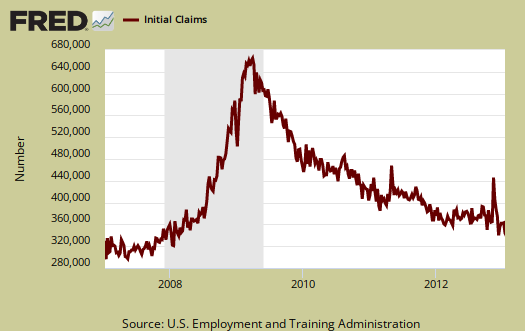The DOL reported Initial weekly unemployment claims for the week ending on January 12th, 2013 were 335,000, a 37,000 drop from the previous week of 372,000. Last week's initial claims were originally reported to be 371,000, a 1,000 upward revision. The 10% weekly initial claims plunge is the lowest level since January 2008, the start of the recession, and also the biggest weekly decline since February 2010. Alas, the decline is only a warm fuzzy and artificial.

As much as people wish it so, most government data is not complete and not real time. We have repeatedly warned, ad nauseum, do not bank on the initial claims number reported in the press release for that week. Initial claims for unemployment benefits is a weekly statistic and that implies a very short time window for data collection, it is always revised the next week, almost always upward. One can have unusual events which throw off the seasonal adjustment algorithm. One can have missed timing of events that can also throw a monkey wrench in one week's worth of data.
This week is a very weird one for seasonal adjustments. The unadjusted data swings wild and the DOL has a seasonal pattern algorithm to smooth out those swings. The 2nd week in January the DOL expects to see a flood of new claims due to the end of seasonal hiring and the worst month for summer type of jobs, such as construction. This week, they didn't see it. Marketwatch clearly did their homework and called the DOL to find the DOL's seasonal expectations for initial claims versus what data was actually reported by the states.
Unadjusted claims don’t rise nearly as much if the second week of January ends on the 12th, as it did in 2013. A Labor official called it an “odd calendar configuration.”In the seven days ended Jan. 12, unadjusted claims were expected by Labor officials to rise 11.7%. Instead, they rose just 0.4%. Raw claims edged up to 555,708 from 553,348 in the prior week.
As we pointed out in our weirdness in initial unemployment claims article, states might not report their quarterly adjustments for emergency unemployment benefits and we had the infamous fiscal cliff push past the final hour, which included extending those unemployment benefits for the long term unemployed. We won't know if some states had a delay in adjusting their quarterly EUC figures until the next two weeks. Seasonal adjustments did come into play. Generally speaking one week's worth of statistics to seasonally adjust and smooth is too sort of a time window to not expect periodic weirdness. Despite our and other's repeated warnings, that doesn't stop people from jumping on whatever weekly number is reported and believing that as fact.
The statistic to pay attention to is the four week moving average on initial unenmployment claims. The four week moving average decreased 6,750 to 359,250. In the below graph we can see we still are not at pre-recession initial weekly unemployment claims levels. If anyone recalls, even before the Great Recession the job market was not so hot. Below is the four week moving average, set to a log scale, from April 1st, 2007.

Below is the mathematical log of initial weekly unemployment claims. A log helps remove some statistical noise, it's kind of an averaging and gives a better sense of a pattern. As we can see, we have a step rise during the height of the recession, but then a leveling, then a very slow decline, or fat tail. That fat tail is our never ending labor market, stuck in the mud, malignant malaise.

Continuing unemployment claims for the previous week increased, and we have large long term unemployed. The below continuing claims figure doesn't include those receiving extended and emergency unemployment benefits.
The advance number for seasonally adjusted insured unemployment during the week ending January 5 was 3,214,000, an increase of 87,000 from the preceding week's revised level of 3,127,000. The 4-week moving average was 3,195,750, a decrease of 6,000 from the preceding week's revised average of 3,201,750.
In the week ending December 29th, not seasonally adjusted, the official number of people obtaining some sort of unemployment insurance benefit was 5,821,966 with 2,059,438 people receiving EUC, which is scheduled was run out in January 2013 and extended in the 11th fiscal cliff hour. There were 12 million official unemployed in December.
.

Recent comments